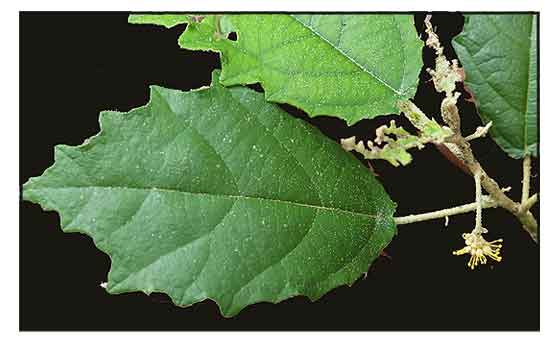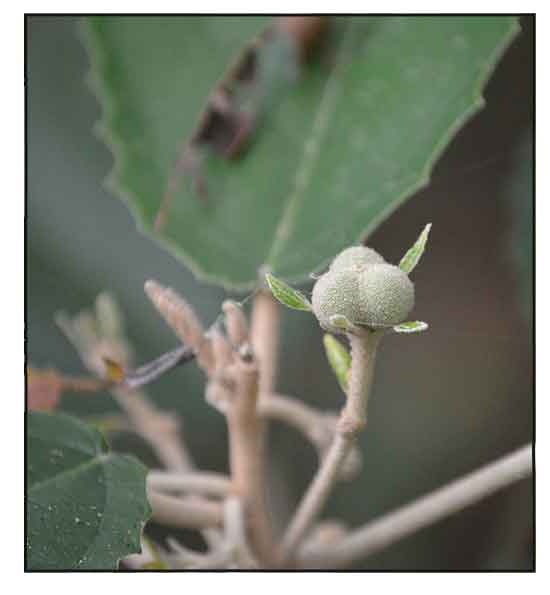
Family • Euphorbiaceae
Cladogynos
Cladogynos orientalis Zipp. ex Span.
CHETTAPHANGKI / JET PUNK KEE
Bai da feng
| Scientific names | Common names |
| Adenochlaena siamensis Ridl. | Cladogynos (Genus) |
| Adenogynum discolor Rchb.f. & Zoll. | |
| Adenogynum odontophyllum Miq. | |
| Baprea bicolor Pierre ex Pax & K.Hoffm. | |
| Cephalocroton albicans var. virens Müll.Arg. | |
| Cephalocroton discolor (Rchb.f. & Zoll.) Müll.Arg. | |
| Cephalocroton orientalis (Zipp. ex Span.) Mq. | |
| Chloradenia discolor (Rchb.f. & Zoll.) Baill. | |
| Cladogynos orientalis Zipp. ex Span. | |
| Cladogynos orientalis var. grossedentata Pax & K.Hoffm. | |
| Cladogynos orientalis var. virens (Müll.Arg.) Pax & K.Hoffm. | |
| Conceveiba tomentosa Span. | |
| Rottlera albicans Hassk. | |
| Cladogynos orientalis is an accepted species. KEW: Plants of the World Online | |
| Other vernacular names |
| CHINA: Bai da feng. |
| THAILAND: Chettaphangki, Jet punk kee, Tong ta phran, Takia, Plao ngoen, Nat takua, Sami, Bai lang khao, Mon khao, Plao nam ngoen. |
Gen info • Shrub, to 3 m high. Leaves: petiole 27.5 cm long; blade ovate to elliptic, 6.5–16 by 2.5–6 cm, base subpeltate, obtuse to rounded, apex acute to acuminate, dark green above, densely white pubescent and floccose beneath. Inflorescences 1–2 long; peduncle 0.5–1 cm long. Flowers yellow-green to white. Staminate flowers in heads of 5–6.5 mm in diam.; sepals ca 1.5 mm long, hairy outside, base and inside glabrous; stamens 2–3 mm long, anthers yellow. Pistillate flowers: sepals 5–6 mm long. Fruits 10–11 by ca 6 mm, white woolly. (e-Flora of Thailand) Distribution Properties Availability |
May 2025
![]()
 |
| Â Â Â Â Â Â Â Â Â Â Â Â Â Â Â Â Â Â Â Â Â Â Â Â Â PHOTOS / ILLUSTRATIONS |
| IMAGE SOURCE: Euphorbiaceae : Cladogynos / Leaf and staminate inflorescence / Copyright © 2016 by John Michael M Galindon (contact: pieter.pelser@canterbury.ac.nz) [ref. DOL106806] / Non-Commercial Use / Image modified / Click on image or link to go to source page / Phytoimages.siu.edu |
| OTHER IMAGE SOURCE: Pterocaulon redolens (Willd.) F.-Vill. / © Wangworn Sankamethawee / Some rights reserved / CC BY-NC / Click on image or lin to go to source page / iNaturalist |
Additional
Sources and Suggested Readings |
• |
DOI: It is not uncommon for links on studies/sources to change. Copying and pasting the information on the search window or using the DOI (if available) will often redirect to the new link page. (Citing and Using a (DOI) Digital Object Identifier) |
| Â Â Â Â Â Â Â Â Â Â Â Â Â Â Â Â Â Â Â Â Â Â Â Â Â Â Â Â Â Â List of Understudied Philippine Medicinal Plants |
| Â Â Â Â Â Â Â Â Â Â Â Â Â Â Â Â Â Â Â Â Â New plant names needed The compilation now numbers over 1,500 medicinal plants. While I believe there are hundreds more that can be added to the collection, they are becoming more difficult to find. If you have a plant to suggest for inclusion, native or introduced, please email the info: scientific name (most helpful), local plant name (if known), any known folkloric medicinal use, and, if possible, a photo. Your help will be greatly appreciated. |
• |
 |



